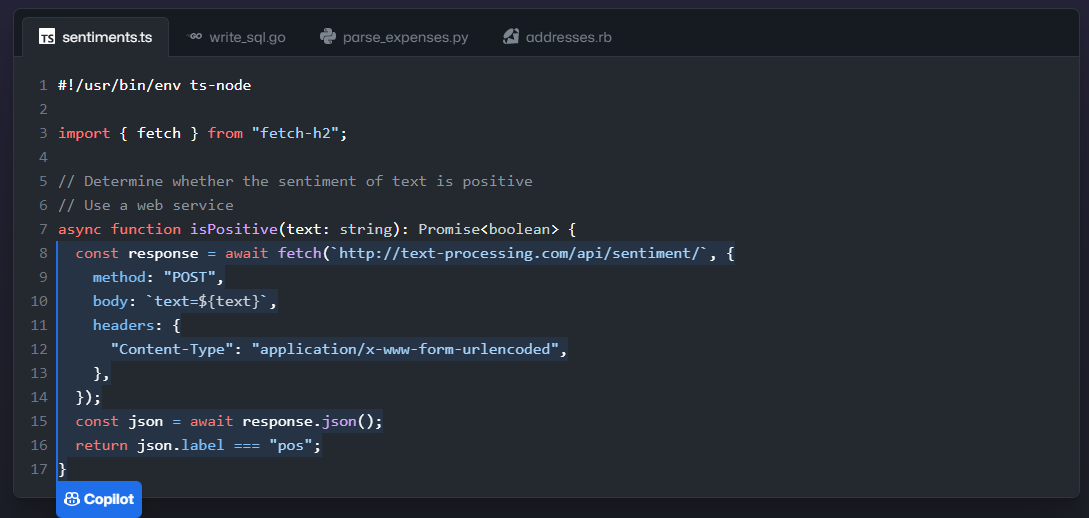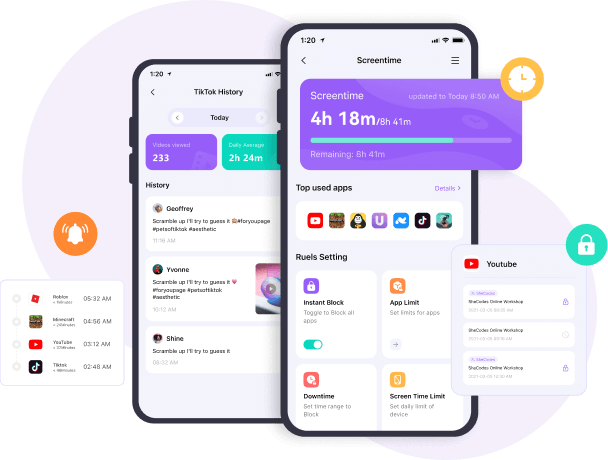AI tools are gaining popularity with every passing day. People are using them in every possible way they can.
But with all this popularity, the rivalry between platforms is becoming more intense. The most talked-about matchup of the moment is undoubtedly GitHub Copilot vs. ChatGPT.
So grab your popcorn because we will hold this battle right now.
This article will compare GitHub Copilot and ChatGPT from different angles. Then we'll discuss who can benefit from AI tools and who may not be suitable.
So let’s start with the basics and give you an understanding of these AI tools first.
Table of Content
- What is GitHub Copilot?
- What is ChatGPT?
- Feature Comparison of GitHub Copilot & ChatGPT
- GitHub Copilot vs. ChatGPT: Pricing
- Pros and Cons of GitHub Copilot & ChatGPT
- GitHub Copilot vs. ChatGPT: Use Cases
- Why Children Shouldn’t Use AI Assistants in Study?
- Ensuring Online Safety for Kids with FamiSafe
What is GitHub Copilot?
Imagine having an AI-powered tool that can generate code for you on the fly. That's precisely what GitHub Copilot is. It uses AI & machine learning technology to provide developers with intelligent code suggestions. As the developer types, GitHub Copilot suggests lines of code that fit with the existing codebase.

The suggestions provided by GitHub Copilot are not just simple templates but fully functional lines of code. The assistant considers the programming language, the libraries & frameworks, and the specific problem the developer is trying to solve. In some cases, GitHub Copilot can even generate entire functions or classes.
After GitHub Copilot, let’s move on and see the other frontier in AI technology.
ChatGPT is an advanced technology that simulates human-like conversations. You just need to input some prompts, and ChatGPT will give you an answer to that prompt. And these responses are so human-like that distinguishing them from human-made ones can be challenging.

The technology behind ChatGPT is based on the GPT-3 architecture, a state-of-the-art language model. This model has achieved remarkable success in various natural language processing tasks. ChatGPT builds upon this architecture and has been trained to simulate human-like conversations.
It's time for the main event: ChatGPT vs. GitHub Copilot. We'll analyze these AI tools from every angle, exploring their features, pricing, and pros and cons.
GitHub Copilot and ChatGPT are two different AI-powered tools that offer unique features to users.
GitHub Copilot Features
GitHub Copilot is designed to provide autocomplete-style suggestions for code. You can also integrate it directly into the coding environment. So when you want to access it, just enter a simple keyboard shortcut. Additionally, GitHub Copilot learns from the code developers write and continuously improves its suggestions. But keep in mind that you cannot have a conversation with it.
ChatGPT Features
On the other hand, ChatGPT is a language model that has been trained on a vast corpus of text data. This allows it to understand natural language inputs and generate appropriate responses. While it can also offer code suggestions like GitHub Copilot, it excels in a conversational context.
And that’s the main difference. You cannot converse with GitHub Copilot as you can with ChatGPT.
Now let’s start round two and see the pricing of these AI tools.
Regarding pricing, GitHub Copilot and ChatGPT differ significantly.
GitHub Copilot Pricing
GitHub Copilot offers a fantastic opportunity for verified students, teachers, and maintainers of popular open-source projects. It is entirely free to use for them.
But if you're not one of them, you can still try GitHub Copilot for free with a one-time 30-day trial. After the trial, you'll need a paid subscription to continue using the tool.
Here are the two subscription plans you can choose from;
- Copilot for Individuals - &10 per month / &100 per year.
- Copilot for Business - $19 per user per month.

ChatGPT Pricing
On the other hand, ChatGPT has a basic version that is entirely free to use, with no limit to usage. But that doesn’t mean there is no paid plan!
ChatGPT Plus is also available for a monthly subscription of $20. With this Plus version, users can enjoy faster response speeds, priority access to new features, and consistent performance even during peak demand.

Now that we've explored the pricing let's dive into the advantages and disadvantages of these innovative AI tools.
Here are some Pros & Cons of GitHub Copilot and ChatGPT
GitHub Copilot
Since GitHub Copilot is an AI tool, you can’t expect it to be perfect. Let’s look at its advantages first. Then we’ll move on to the disadvantages.
Pros
- GitHub Copilot can complete algorithms or snippets of code upon command input.
- The AI can show developers any compilation problems and propose solutions.
- Supports Pair Programming for collaborative programming and alternative solutions.
- Copilot can suggest code in different languages through its translation tool.
- Developers can save time using Copilot to focus on writing rather than high-level reasoning.
Cons
- Copilot is unsuitable for junior developers due to possible writing complications.
- Copilot may create security problems that only experienced developers can avoid.
- Copilot does not test code and may lead to wasted time and effort.
- Copilot may disrupt natural thinking and lead to code changes.
- Code theft and copyright infringement concerns are also present.
- Copilot is a paid subscription service, and users must determine if the cost is worth it.
ChatGPT
Just like the GitHub Copilot, ChatGPT also has both benefits and limitations. Here are the key pros & cons of using ChatGPT.
Pros
- Provides instant answers to questions without the need to search on websites.
- Can understand natural language and human behavior.
- Free to use with no cost issues.
- Allow users to ask questions and receive answers in their preferred language.
- It can generate human-like responses that are contextually appropriate and engaging.
- ChatGPT is constantly improving and learning from its interactions with users.
- It can be integrated with other applications and services.
Cons
- The responses from ChatGPT are not always accurate or reliable.
- It is not as effective when visual or auditory communication is necessary.
- ChatGPT may struggle with complex questions that require domain-specific knowledge.
- There are concerns about privacy and security when using chatbots like ChatGPT.
- ChatGPT cannot provide emotional support or human empathy in the same way a human being can.
- It may be challenging to determine the source of information provided by ChatGPT.
- ChatGPT's reliance on pre-existing limited data may perpetuate inaccuracies in the training data.
After looking at the pros & Cons of the two AI tools, you must be getting clear about these AI tools.
Now let’s move forward and take a look at their use cases.
GitHub Copilot Use Cases
GitHub Copilot can be used in a variety of scenarios, including:
1. Writing Code Quickly
Copilot can provide suggestions based on the code being written. So developers can now write their code quickly and accurately.
2. Learning to Code
You can also use Copilot as a learning tool, as it provides suggestions & examples of code.
3. Collaborative Coding
Copilot can be used in a team environment to help multiple developers collaborate on code and increase productivity.
4. Refactoring
Copilot can suggest alternative codes that can improve the performance of your program.
5. Code Review
You can use Copilot to suggest improvements and highlight potential issues. This can help you review your codes.
6. Prototyping
Copilot can also be used to prototype new software features quickly.
Now let’s move on to the use cases of ChatGPT.
ChatGPT Use Cases
ChatGPT has a wide range of use cases. Here are some that are worth noticing.
1. Customer Service
ChatGPT can be used to provide automated customer service. It can answer frequently asked questions and help customers resolve issues.
2. Healthcare
ChatGPT can be used to provide medical advice and help patients schedule appointments with doctors.
3. Personal Assistants
People are also using ChatGPT as a virtual assistant. Using ChatGPT, users can manage their schedules, book appointments, and perform other tasks.
4. Language Translation
Another vital use of ChatGPT is translating text from one language to another. This ability makes it a handy tool for international communication.
5. Content Creation
ChatGPT can also generate content for blogs, social media, and other digital platforms.
6. Research
ChatGPT is a powerful tool that can assist researchers with data analysis and information gathering.
7. Entertainment
You can use ChatGPT as a chatbot companion or game character. This provides users with an interactive and entertaining experience.
After looking at these uses of AI tools, you might think there are no situations where we should avoid them. But that is not the case.
Using tools like ChatGPT by children can be extremely harmful to them in the long run.
Let’s see why children shouldn’t use AI assistants in study.
In recent years, the prevalence of AI assistants in education has skyrocketed. Nonetheless, regarding the utilization of AI assistants by children, certain risks and concerns must be taken into account. In fact, some schools have already prohibited the use of AI tools in the classroom.
Still don’t believe me? Here are some of the risks that the kids might encounter.
Dependency
One issue with children using AI assistants is that they may become overly dependent on these tools. Instead of learning critical thinking, children rely too heavily on answers provided by AI. So the outcome? A lack of independence and self-sufficiency.
Incorrect or Biased information
Another concern is that AI assistants may provide incorrect or biased information. Children may not have the knowledge or experience to recognize when AI provides faulty information. This could lead to confusion, misinformation, or even academic dishonesty.
Security Problems
Security problems are another risk associated with children using AI assistants in their studies. These tools may collect and store sensitive information, such as personal details or search history.
Lack of Social Interaction
Learning is not just about acquiring knowledge but also about building relationships and developing communication skills. The use of AI assistants may limit children's opportunities for social interaction with peers & teachers. Children who rely heavily on AI assistants may miss out on these important aspects of education.
Possible Cheating & Plagiarism
Some AI tools can generate text, complete assignments, and even take exams on behalf of the student. This raises the risk of students cheating and plagiarizing their work. It can be tempting for students to rely on these tools to complete their work. But it ultimately undermines the purpose of education and learning.
That’s a lot of risks, right? So is there a way to prevent our children from using ChatGPT? Until they learn how to use it at least properly!
Of course, there is!!!
And we are going to reveal this in our next section.
Are you concerned about your child's safety and productivity while using their phone? FamiSafe is the solution you need.
FamiSafe offers your kids a safe and supervised environment with its various features. You can even prevent your child from using AI tools like ChatGPT by monitoring their activity. And that’s not all!!!

There are also many other features that can help you monitor your kids.
Features of Wondershare FamiSafe
- Activity Report: To monitor your kid's phone activities, app usage, and app installs/uninstalls.
- App Blocker: To block or limit the usage of apps on your kid's phone.
- Set Screen Time: To manage screen time for each app and block social or game apps.
- Parent Alerts: To get alerts for explicit or offensive words and set custom alerts.
- Location Tracking: Real-time location tracking and location history review. There are also alerts for entering or leaving geofences.
The use of AI tools is skyrocketing, and it's not hard to see why. They're making our lives easier and more convenient in countless ways. But with this popularity comes fierce competition between platforms. The biggest showdown of them all is GitHub Copilot vs. ChatGPT.
Our comparative analysis of these two AI tools will help you determine which one is the right fit for you.
But don’t forget to keep your kids away from these AI tools with Wondershare FamiSafe. Their usage is bound to cause damage in the long run.
